The AMD A8-7650K APU Review, Also New Testing Methodology
by Ian Cutress on May 12, 2015 10:00 AM ESTGaming Benchmarks: Mid-Range
Alien: Isolation
If first person survival mixed with horror is your sort of thing, then Alien: Isolation, based off of the Alien franchise, should be an interesting title. Developed by The Creative Assembly and released in October 2014, Alien: Isolation has won numerous awards from Game Of The Year to several top 10s/25s and Best Horror titles, ratcheting up over a million sales by February 2015. Alien: Isolation uses a custom built engine which includes dynamic sound effects and should be fully multi-core enabled.
For low end graphics, we test at 720p with Ultra settings, whereas for mid and high range graphics we bump this up to 1080p, taking the average frame rate as our marker with a scripted version of the built-in benchmark.
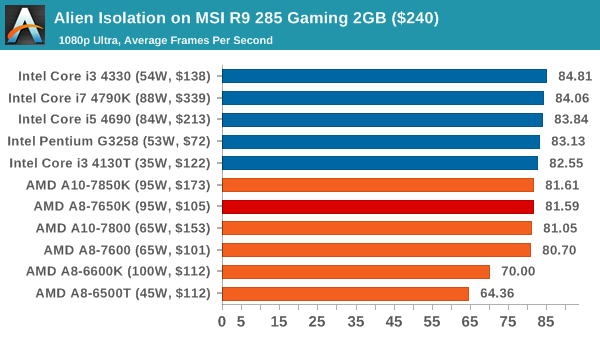
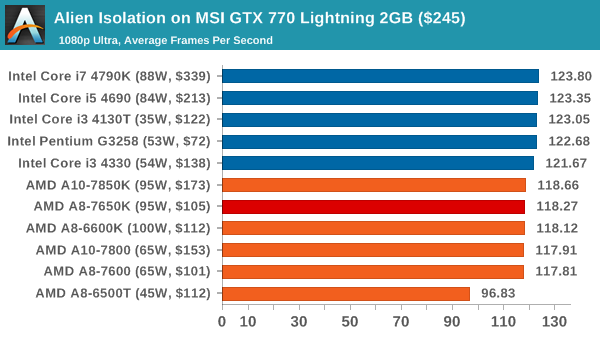
For mid range cards, Alien Isolation has a direct split for Intel and AMD, but the difference is a few FPS at best. It would seem that cores matter not here.
Total War: Attila
The Total War franchise moves on to Attila, another The Creative Assembly development, and is a stand-alone strategy title set in 395AD where the main story line lets the gamer take control of the leader of the Huns in order to conquer parts of the world. Graphically the game can render hundreds/thousands of units on screen at once, all with their individual actions and can put some of the big cards to task.
For low end graphics, we test at 720p with performance settings, recording the average frame rate. With mid and high range graphics, we test at 1080p with the quality setting. In both circumstances, unlimited video memory is enabled and the in-game scripted benchmark is used.
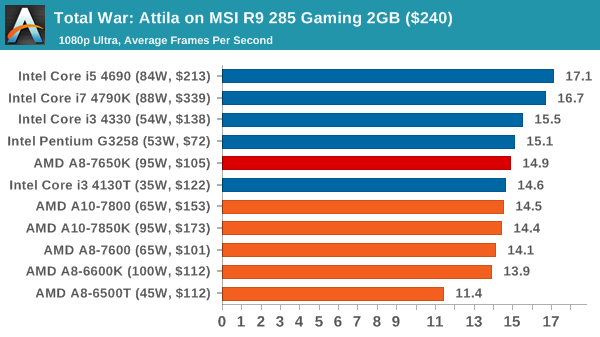
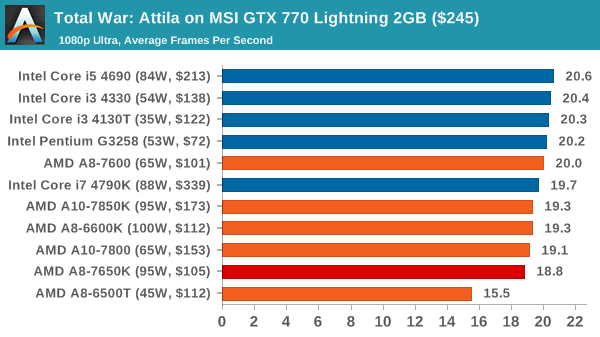
Neither combination here pulls Attila into a reasonable gaming rate, although there are bigger differences using the R9 285 GPU.
Grand Theft Auto V
The highly anticipated iteration of the Grand Theft Auto franchise finally hit the shelves on April 14th 2015, with both AMD and NVIDIA in tow to help optimize the title. GTA doesn’t provide graphical presets, but opens up the options to users and extends the boundaries by pushing even the hardest systems to the limit using Rockstar’s Advanced Game Engine. Whether the user is flying high in the mountains with long draw distances or dealing with assorted trash in the city, when cranked up to maximum it creates stunning visuals but hard work for both the CPU and the GPU.
For our test we have scripted a version of the in-game benchmark, relying only on the final part which combines a flight scene along with an in-city drive-by followed by a tanker explosion. For low end systems we test at 720p on the lowest settings, whereas mid and high end graphics play at 1080p with very high settings across the board. We record both the average frame rate and the percentage of frames under 60 FPS (16.6ms).
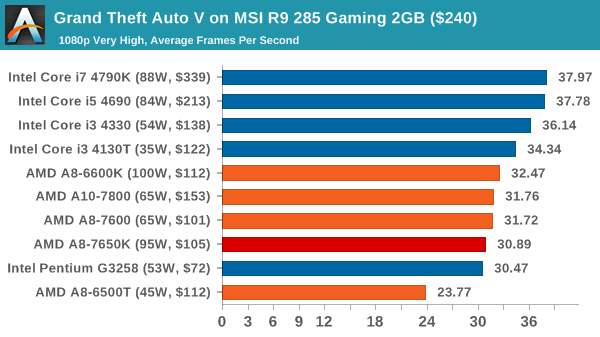
![Grand Theft Auto V on MSI R9 285 Gaming 2GB ($240) [Under 60 FPS]](https://images.anandtech.com/graphs/graph9217/74236.png)

![Grand Theft Auto V on MSI GTX 770 Lightning 2GB ($245) [Under 60 FPS]](https://images.anandtech.com/graphs/graph9217/74246.png)
On GTA, the G3258, the i3-4130T and the A8-7650K perform similarly, within a few frames of each other. Though in both circumstances the $200+ CPUs give the peak performance, up to 20% more than the $100 set.
GRID: Autosport
No graphics tests are complete without some input from Codemasters and the EGO engine, which means for this round of testing we point towards GRID: Autosport, the next iteration in the GRID and racing genre. As with our previous racing testing, each update to the engine aims to add in effects, reflections, detail and realism, with Codemasters making ‘authenticity’ a main focal point for this version.
GRID’s benchmark mode is very flexible, and as a result we created a test race using a shortened version of the Red Bull Ring with twelve cars doing two laps. The car is focus starts last and is quite fast, but usually finishes second or third. For low end graphics we test at 1080p medium settings, whereas mid and high end graphics get the full 1080p maximum. Both the average and minimum frame rates are recorded.
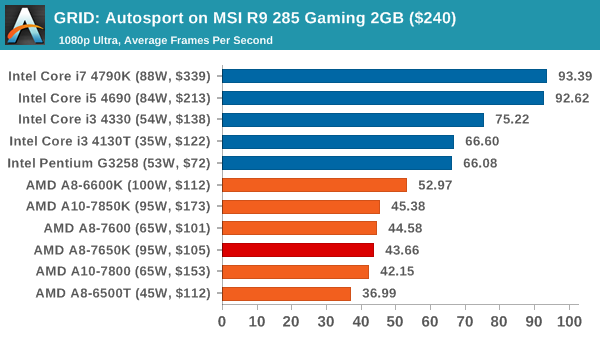
![GRID: Autosport on MSI R9 285 Gaming 2GB ($240) [Minimum FPS]](https://images.anandtech.com/graphs/graph9217/74238.png)

![GRID: Autosport on MSI GTX 770 Lightning 2GB ($245) [Minimum FPS]](https://images.anandtech.com/graphs/graph9217/74248.png)
GRID on an R9 285 seems to love Intel and loves more cores, as shown by the jump from the i3 to the i5. Whereas on a GTX 770, both teams perform similarly, well north of 60 FPS, although the difference lies more in the minimum frame rates.
Middle-Earth: Shadows of Mordor
The final title in our testing is another battle of system performance with the open world action-adventure title, Shadows of Mordor. Produced by Monolith using the LithTech Jupiter EX engine and numerous detail add-ons, SoM goes for detail and complexity to a large extent, despite having to be cut down from the original plans. The main story itself was written by the same writer as Red Dead Redemption, and it received Zero Punctuation’s Game of The Year in 2014.
For testing purposes, SoM gives a dynamic screen resolution setting, allowing us to render at high resolutions that are then scaled down to the monitor. As a result, we get several tests using the in-game benchmark. For low end graphics we examine at 720p with low settings, whereas mid and high end graphics get 1080p Ultra. The top graphics test is also redone at 3840x2160, also with Ultra settings, and we also test two cards at 4K where possible.
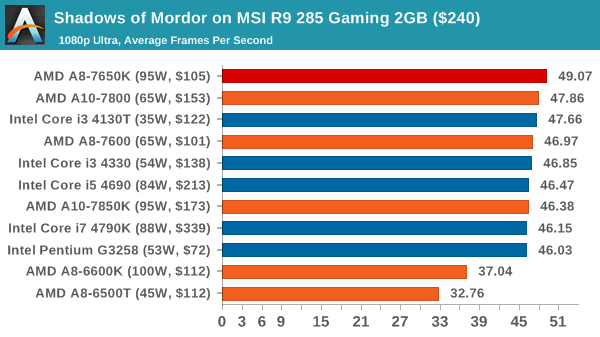
![Shadows of Mordor on MSI R9 285 Gaming 2GB ($240) [Minimum FPS]](https://images.anandtech.com/graphs/graph9217/74240.png)
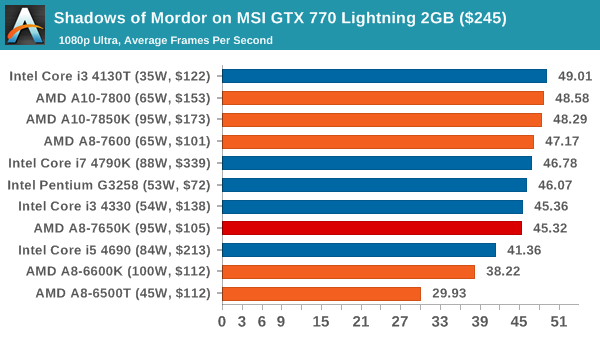
![Shadows of Mordor on MSI GTX 770 Lightning 2GB ($245) [Minimum FPS]](https://images.anandtech.com/graphs/graph9217/74250.png)
Interestingly the APUs so well at 1080p SoM, especially in average frame rates. Unfortunately this does not translate well in minimum frame rates.
Middle-Earth: Shadows of Mordor at 4K
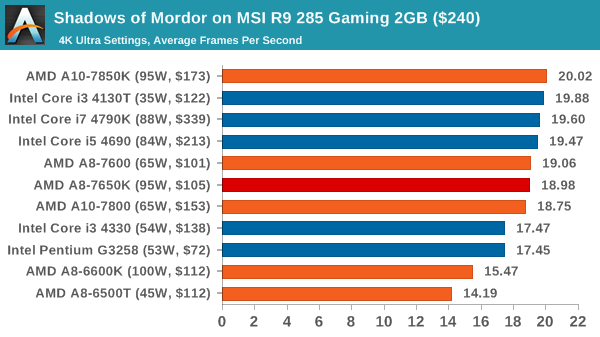
![Shadows of Mordor on MSI R9 285 Gaming 2GB ($240) [Minimum FPS]](https://images.anandtech.com/graphs/graph9217/74240.png)
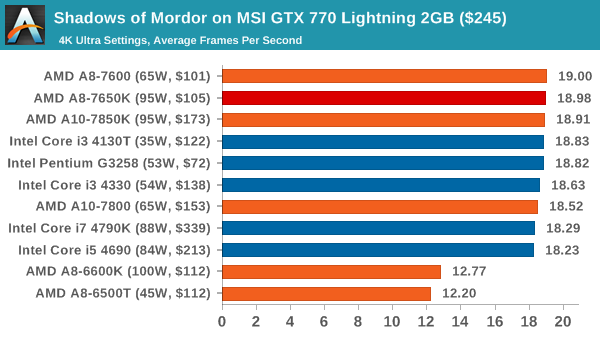
![Shadows of Mordor on MSI GTX 770 Lightning 2GB ($245) [Minimum FPS]](https://images.anandtech.com/graphs/graph9217/74252.png)
At 4K, the older 6000 series APUs seem to be a little behind. With the R9 285 there is also a staggered affect in average FPS performance, although a clear definition in minimum frame rates.















177 Comments
View All Comments
r3loaded - Tuesday, May 12, 2015 - link
Now, more than ever, AMD needs Zen. They still have nothing out on the market that can conclusively beat my four year old 2500K.close - Tuesday, May 12, 2015 - link
Even Intel barely has something that can conclusively beat your four year old 2500K :). Progress isn't what it used to be.Frenetic Pony - Tuesday, May 12, 2015 - link
That's because Intel's efforts are solely focused on laptops/mobile. They dominate the high end, and would only compete with themselves. This at least leaves AMD an opening next year though, as cramming battery life into the Core series has stalled Intel's development of performance per mm^2 other than process shrink.mapesdhs - Tuesday, May 12, 2015 - link
Especially once oc'd of course. What clock are you using?I'm building a 2500K system for a friend atm, easily the best value on a very limited budget.
r3loaded - Tuesday, May 12, 2015 - link
4.5Ghz for full time use on air in my own system. But yeah, even at stock speeds it's still not a contest for the Intel chip.der - Tuesday, May 12, 2015 - link
Awesome testing Methology guys, and definitely a great review.azazel1024 - Tuesday, May 12, 2015 - link
Ian, I'll grant you it isn't abysmal performance and I doubt most casual users would notice a difference. It doesn't seem honest to say that, "While the APUs aren't necessarily ahead in terms of absolute performance, and in some situations they are behind, but with the right combination of hardware the APU route can offer equivalent performance at a cheaper rate"Uhhhh, unless I misread the benchmarks, the AMD processors are at least a little behind to a lot behind vaguely similarly priced Intel processors in the vast majority of CPU benchmarks. That doesn't say "in some" to me, that to me says in most are almost all.
The only place I see them is either extreme budget or your size constrictions prevent you from getting even a cheap discrete graphics card. Cost and performance wise, you'd probably be better off with something like a GTX750 or 750ti combined with an Intel Celeron or Pentium Haswell processor.
I really want Zen to be a turn around.
A quick Amazon check shows that an Intel Haswell Pentium, plus H97 board, plus 2x2GB of DDR3-1600 and a GTX750 would run you in the region of $250. Granted that doesn't include case ($30 for low end), PSU ($40 for a good low power one) or storage ($90 for a 120GB SSD or $50-60 for a 2TB HDD), but it sounds like it was well within that $300 budget considering the bits that could have/were reused...
Deffinitely to each his own, I just think especially once you start getting in to "dual graphics" (even low end), you are almost certainly better if you are talking two discrete cards, or just getting a slightly faster discrete card than relying on the iGPU+dGPU to drive things as well as a somewhat better processor, that might not be any more expensive (or cheaper, Haswell Pentium/Celeron).
galta - Tuesday, May 12, 2015 - link
No matter what people say, AMD is driving itself into an ever tighter corner, be it on the CPU or GPU realms.One really has a hard time trying to justify choosing them over Intel/nVidia, but for some very specific – and sometimes bizarre - circumstances (eg.: because the only thing I do is compact files on WinRar, I end up finding AMD FX and its 8 cores the best cost/benefit ratio!)
A8-7650K is no different.
It is said that things are like that. As a consumer with no intrinsic brand preferences, I would like to see real competition.
anubis44 - Tuesday, May 12, 2015 - link
Try compressing those files using 7Zip, and you'll see a dramatic improvement on the FX-8350. 7Zip is highly optimized for multi-threading, whereas WinRAR is single-threaded.galta - Tuesday, May 12, 2015 - link
No, it's not: http://forums.anandtech.com/showthread.php?t=22533...Even if it were, that's not the point.
How many of us, inclunding the bizarre ones, do only compacting on their PCs?